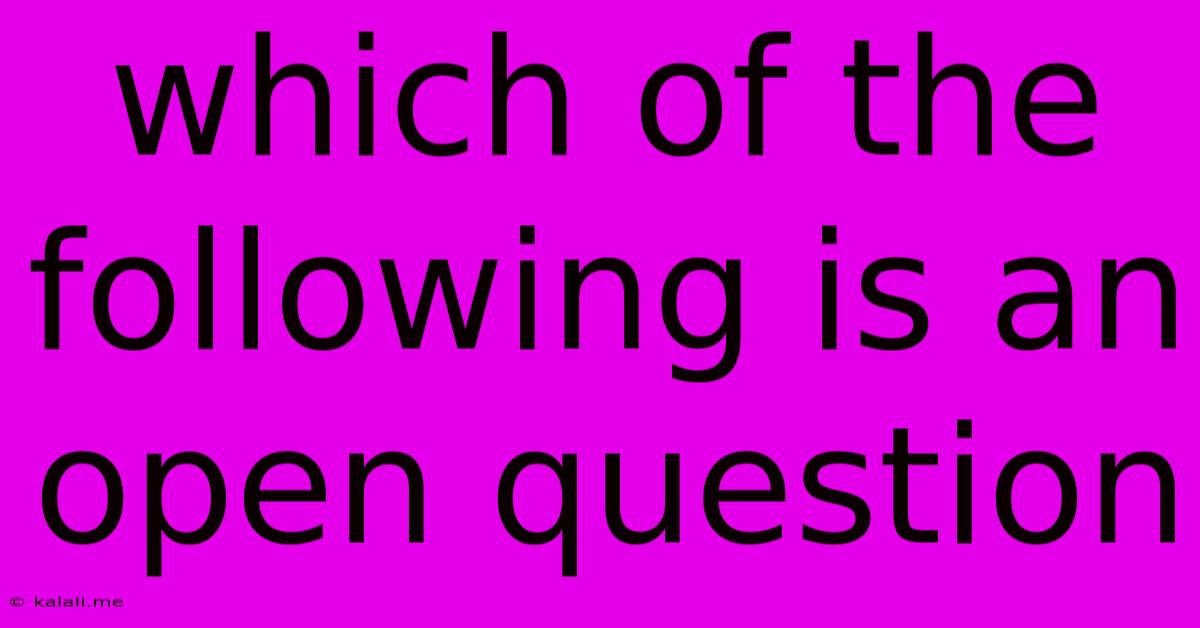Which Of The Following Is An Open Question
Kalali
Jun 13, 2025 · 2 min read

Table of Contents
Which of the following is an open question? Unlocking the Power of Open-Ended Inquiry
This article delves into the crucial difference between open and closed questions, focusing on how to identify an open question and why they're essential in various contexts, from research to casual conversation. Understanding this distinction is key for effective communication and data gathering.
What are Open and Closed Questions?
Before we determine which question type from a given list is open, let's define each:
-
Closed Questions: These questions elicit short, specific answers, often a single word or a very brief phrase. They typically restrict the respondent to pre-defined options. Examples include "yes/no" questions or those offering a limited selection of answers (e.g., multiple choice). They're great for gathering quick facts and data but limit the depth of information.
-
Open Questions: These questions encourage detailed, thoughtful responses. They provide space for the respondent to express their opinions, feelings, and experiences freely. Open questions often begin with words like "what," "why," "how," "tell me about," or "describe." They are invaluable for gaining insights into perspectives and understanding nuanced viewpoints.
Identifying an Open Question: Key Characteristics
Several characteristics help distinguish an open question:
-
No pre-defined answers: Open questions don't offer a limited set of responses. The respondent is free to answer in their own words.
-
Prompts elaboration: They invite the respondent to expand on their thoughts and feelings. Short, simple answers are insufficient.
-
Subjectivity welcomed: Open questions often tap into subjective experiences, opinions, and beliefs.
-
Flexibility in response: There’s a wide range of acceptable answers, making them ideal for exploring complex topics.
Examples to Illustrate the Difference
Let's look at some examples to solidify the understanding:
Closed Question: "Are you satisfied with our service?" (Yes/No answer)
Open Question: "What aspects of our service could be improved?" (Allows for detailed feedback)
Closed Question: "What is your age?" (Single numerical answer)
Open Question: "Tell me about your experiences as you aged." (Prompts a narrative response)
Closed Question: "Do you prefer tea or coffee?" (Choice between two options)
Open Question: "Describe your ideal morning beverage routine." (Invites detailed description)
Why are Open Questions Important?
The power of open questions lies in their ability to:
- Gather rich qualitative data: Essential for research, interviews, and customer feedback.
- Foster deeper understanding: Uncover underlying reasons and motivations.
- Encourage active participation: Engage respondents and make them feel heard.
- Build rapport: Create a more conversational and less formal atmosphere.
- Improve decision making: Inform decisions based on in-depth insights, not just surface-level data.
Conclusion:
Determining which question is open hinges on whether it invites a detailed, subjective, and expansive answer. Mastering the art of asking open questions is a valuable skill across diverse fields, leading to richer communication, valuable data, and more informed choices. By understanding the nuances between open and closed questions, you can significantly enhance your interactions and the insights you gather.
Latest Posts
Latest Posts
-
Which Of The Following Is Not Considered Appropriate Email Etiquette
Jun 14, 2025
-
Which Of The Following Is Not A Major Mineral
Jun 14, 2025
-
Whats The Square Root Of 149
Jun 14, 2025
-
What Are The Factors For 62
Jun 14, 2025
-
Si Unit For Density Of Water
Jun 14, 2025
Related Post
Thank you for visiting our website which covers about Which Of The Following Is An Open Question . We hope the information provided has been useful to you. Feel free to contact us if you have any questions or need further assistance. See you next time and don't miss to bookmark.